When my parents retired they moved out of their house of almost twenty-five years in the Los Angeles area. Not wanting to pick favorites between their two children they decided on a modest house in a new development in Oceanside, halfway between my sister and me.
Like many new homes the landscaping that came with the place was bare-bones: lawn, with a single podocarpus sapling next to the front curb. The blank slate excited my mother, who was looking forward to putting her stamp on a new piece of property. I helped her plan the yard, construct the raised beds, move dirt and do some of the planting. In the end, though, almost all the plant selections were hers: oleanders, pittosporum, geraniums, roses, azaleas, agapanthus, bird of paradise, Japanese maple, citrus, stone fruit trees, plus selections from the other plants that were being promoted twenty years ago.
When my mother died in the late 90s it left my father with a yard that wasn’t exactly what you’d call low-maintenance. And Oceanside wasn’t a quick drive up for me so that I could help tend it. Several years later he moved out, leaving the gardener’s garden in the hands of renters, many of whom never watered or tended it.
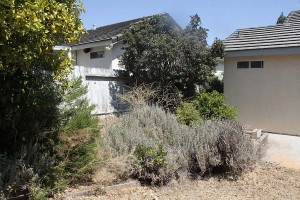
Last summer I had a chance to stop by the house for what will probably be my last visit. Many plants were still alive, thanks in part to what had been a moderately moist winter and spring, with more thanks probably going to the neighbors who watered their lawns and unknowingly kept the ground moist for thirsty roots from next door to sneak under the side fence.

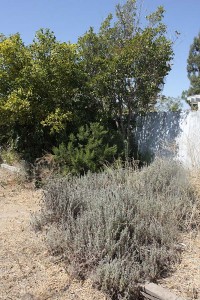

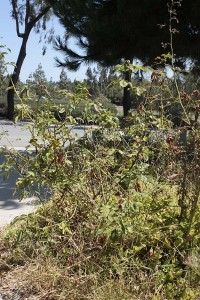

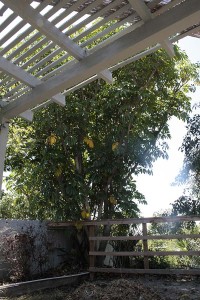

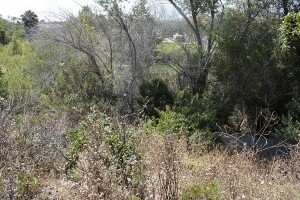
The house is in the hands of new owners now. They’ll probably look at the ragged plantings and decide to start fresh, removing most of the scrappy plants and making the yard their own.
If I hadn’t seen the yard in its current state I might have felt protective or territorial. But this visit allowed me to let go. This was once a comfortable and beautifully maintained garden that gave my parents joy. I have those memories, but I realize that’s not what the garden is anymore.
I now feel at peace with whatever the new owners will want to do with the yard. I wish them well.

It is difficult to move on from a garden. I have no wish to go back to past properties as I assume that I will be upset. One garden had a stunning huge Acer and I know that the new owner wanted to rip it out for some weird reason and I couldnt bear it if it wasn’t there.
That’s great you had a gardener mom. It sounds like it was a classic Southern California garden. Some of the trees look like keepers, so I think your mom should have some sort of legacy. Most people would at least consider keeping the maple and the citrus. Funny how coyote bush always moves in.
Ah, remember when we did our “Our Gardens when we’re Gone” posts? Here it is, for real! How interesting the Japanese maple survived. And I agree, it’s kind of a good feeling to imagine the rebirth of this garden…
I’m not mature when it comes to letting go. 🙂 When I’m back in Minneapolis, for work, or play, I always drive by the old homestead to make sure the new owners are taking good care of the Flowering Almonds.
So I wonder will you go by and check on it in a few years to see what they’ve accomplished?
Helen, it’s the large plants that bother me the most when they’re removed. You obviously spent time enjoying that three that someone after you despised. There’s an issue of taste with plants, but you’d think that a mature focal point would be spared.
Ryan, I’ve seen coyote bush hundreds of feet from the closest possible source. Those seeds that disperse in the wind are super efficient. I’ve even had one here at my house, a few minutes’ walk from the closest canyon edge.
TM, I absolutely do remember that set of posts, and I was thinking about them all the time that I was writing this. There were lots of small plants that didn’t make it, and it’s interesting that the mature specimens end up being tougher than I’d given them credit for being.
Kate, how can you stop caring about a space where you’ve spent part of your life? I don’t blame you for checking in on things!
Loree, I’d be curious to see what it looks like, for sure. The fact that I never lived there would give me a little extra distance that would probably let me accept whatever they do. But if they put down astroturf, well they just might hear from me…
We recently sold our former home, which had been leased out or vacant for 2 years. The garden wasn’t completely untended during most of that time, but it was definitely left to its own resources in ways it hadn’t been when I lived there. I found it easier to let go when it was fresh and well-tended. By the time it sold, I was feeling sorry for it. I hope it gets some love from the new owners, but it won’t surprise me to drive by one day and see no garden, only lawn again. For now I refrain from driving by.
One person’s Shangri La is another’s WTF. Revisiting old passions is hard to resist, but only the stout of heart should try it. I never go to class reunions.
Sad. Why did you have to play off my melancholy and nostalgia, my two sins? I just found out my family’s homestead in Oklahoma went up for auction today. It’s where my great great grandparents settled in 1894. My uncle tried to buy it, get it back in the family, but the price went to high. Then I think about my garden, the inevitable loss and abuse when I will have to leave it and start anew. I shudder at the idea of somone putting sod over it, but in suburbia it’s likely a fair bet. I’m glad you can let go so easily (it seems).
This is a beautiful post.
I too had to let Mom and Dad’s house go, in the emotional sense. Mom and Dad were a huge part of my life that suddenly vanished into death.
I had to realize that their house was not them; their stuff that I brought home is not them. I had to realize that there is a choice between wallowing in their loss or moving on, wiser and stronger.
Somehow if we are lucky, we make the right choice.